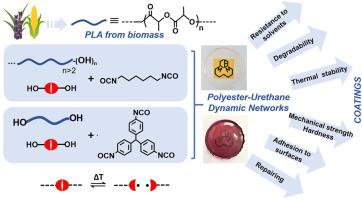Polylactide-based dynamic networks with varying structures and physical properties suitable for potential application as protective polymer coatings
IF 4.5
2区 化学
Q2 POLYMER SCIENCE
引用次数: 0
Abstract
Polylactide (PLA)-based polymer networks containing groups with easily thermally dissociating covalent bonds were synthesized by coupling together oligomeric PLAs bearing hydroxyl groups with low-molecular-weight functional diols (introducing reversible bonds) using di- or tri-isocyanates. The formation of networks, characterized by high gel content (97-98%) and a comparable density of reversible bonds and urethane linkages, was confirmed by FTIR analysis.The polymer networks incorporating thermally reversible disulfide or tetraphenylethane (TPE) groups, which impart their dynamic character, were composed of different building blocks, resulting in varying physical properties. DSC and TGA analyses revealed that the networks showed no significant differences in thermal properties, with glass transition temperatures (Tg) ranging from 43 to 70 °C and maximum decomposition temperatures (Tmax. decomp.) between 246 and 277 °C.Solubility tests in CDCl3 and DMSO indicated high resistance to these solvents, while the networks degraded in alcohols. Alkaline and enzymatic hydrolysis studies revealed the lowest resistance for the most hydrophilic network, containing disulfide groups. Mechanical properties were evaluated by tensile testing, while the elastic modulus and hardness were assessed via nanoindentation method. Networks containing reversible TPE groups exhibited the highest hardness and environmental resistance. These systems were further tested for adhesion to steel and ceramic substrates, demonstrating potential as coating materials. It was also shown that minor surface damage, such as scratches, could be readily repaired at elevated temperatures due to the presence of reversible TPE groups in the network structure.In conclusion, polymer films derived from PLA-based networks containing reversible TPE groups demonstrated high mechanical strength, enhanced resistance to solvents and degradative environments, and the ability to undergo thermal repair. These features highlight their suitability for protective coatings under more demanding conditions.

基于聚乳酸的动态网络具有不同的结构和物理性质,适合作为保护性聚合物涂层的潜在应用
采用二异氰酸酯或三异氰酸酯将含羟基的低聚聚乳酸与低分子量功能二醇(引入可逆键)偶联,合成了具有易热解离共价键的聚乳酸基聚合物网络。FTIR分析证实了该网络的形成,其特点是凝胶含量高(97-98%),可逆键和氨基甲酸乙酯键的密度相当。包含热可逆二硫或四苯基(TPE)基团的聚合物网络,赋予其动态特性,由不同的构建块组成,导致不同的物理性质。DSC和TGA分析显示,这些网络的热性能没有显著差异,玻璃化转变温度(Tg)在43 ~ 70℃之间,最大分解温度(Tmax)在43 ~ 70℃之间。分解)在246到277°C之间。在CDCl3和DMSO中的溶解度测试表明对这些溶剂具有很高的抗性,而网络在醇中降解。碱性和酶解研究表明,最亲水的网络,含有二硫基团的阻力最低。通过拉伸测试测试材料的力学性能,通过纳米压痕法测试材料的弹性模量和硬度。含有可逆TPE基团的网络具有最高的硬度和环境抗性。这些系统进一步测试了与钢和陶瓷基材的附着力,证明了作为涂层材料的潜力。研究还表明,由于网络结构中存在可逆的TPE基团,轻微的表面损伤,如划痕,可以在高温下很容易修复。总之,含有可逆TPE基团的pla基网络衍生的聚合物薄膜具有较高的机械强度,增强了对溶剂和降解环境的抵抗能力,以及进行热修复的能力。这些特点突出了它们在更苛刻条件下的保护涂层的适用性。
本文章由计算机程序翻译,如有差异,请以英文原文为准。
求助全文
约1分钟内获得全文
求助全文
来源期刊

Polymer
化学-高分子科学
CiteScore
7.90
自引率
8.70%
发文量
959
审稿时长
32 days
期刊介绍:
Polymer is an interdisciplinary journal dedicated to publishing innovative and significant advances in Polymer Physics, Chemistry and Technology. We welcome submissions on polymer hybrids, nanocomposites, characterisation and self-assembly. Polymer also publishes work on the technological application of polymers in energy and optoelectronics.
The main scope is covered but not limited to the following core areas:
Polymer Materials
Nanocomposites and hybrid nanomaterials
Polymer blends, films, fibres, networks and porous materials
Physical Characterization
Characterisation, modelling and simulation* of molecular and materials properties in bulk, solution, and thin films
Polymer Engineering
Advanced multiscale processing methods
Polymer Synthesis, Modification and Self-assembly
Including designer polymer architectures, mechanisms and kinetics, and supramolecular polymerization
Technological Applications
Polymers for energy generation and storage
Polymer membranes for separation technology
Polymers for opto- and microelectronics.
 求助内容:
求助内容: 应助结果提醒方式:
应助结果提醒方式:


